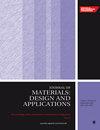Tribological behavior of silver-doped eggshell-derived hydroxyapatite reinforcement in PMMA-based composite
IF 2.2
4区 材料科学
Q3 MATERIALS SCIENCE, MULTIDISCIPLINARY
Proceedings of the Institution of Mechanical Engineers, Part L: Journal of Materials: Design and Applications
Pub Date : 2024-03-25
DOI:10.1177/14644207241240623
引用次数: 0
Abstract
Polymethylmethacrylate (PMMA) and hydroxyapatite (HAp) are the two most promising biocompatible materials used in biomedical applications. The current research performs the wettability and tribological characterization of the novel hybrid biocomposite of PMMA reinforced with eggshell-derived, silver-doped hydroxyapatite (HAPAg). Varying wt% of HAPAg in PMMA were analyzed using a ball-on-disk tribometer. The coefficient of friction shows an increasing trend with an increase in normal load for all the compositions while, with reinforcement of HAPAg, it increases till 5 wt% and then shows a sudden decrement at PHA7.5 due to the formation of flattened asperities at the contact surface. However, the progressive increase in hardness with the inclusion of HAPAg in PMMA correlates with the reduction in the wear rate of the composite samples. The highest wear rate was observed for PHA0 (i.e. 862.42 × 10聚甲基丙烯酸甲酯基复合材料中的掺银蛋壳羟基磷灰石增强材料的摩擦学行为
聚甲基丙烯酸甲酯(PMMA)和羟基磷灰石(HAp)是生物医学应用中最有前途的两种生物相容性材料。目前的研究对新型混合生物复合材料进行了润湿性和摩擦学表征,这种复合材料是用蛋壳衍生的掺银羟基磷灰石(HAPAg)增强的 PMMA。使用球盘摩擦仪分析了 PMMA 中不同重量百分比的 HAPAg。在所有成分中,摩擦系数都随着法向载荷的增加而呈上升趋势,而在添加 HAPAg 后,摩擦系数在 5 wt% 前会增加,但在 PHA7.5 时会突然下降,原因是在接触表面形成了扁平的尖角。不过,随着 HAPAg 加入 PMMA,硬度逐渐增加,复合材料样品的磨损率也随之降低。据观察,PHA0 的亲水性增加(接触角从 96.30° ± 2.11° [PHA0] 变为 81.70° ± 1.01° [PHA7.5]),孔隙率降低(≈2.86%),PMMA 中的 HAPAg 增强进一步提高了复合材料的内聚强度和微硬度。X 射线光电子能谱和傅立叶变换红外光谱分析证实了 HAPAg 的均匀增强,并使用扫描电子显微镜、立体变焦显微镜和三维表面轮廓仪对磨损表面行为进行了检测。较高载荷下的低特定磨损特性确保了所开发的生物复合材料在牙科和矫形外科领域的应用。
本文章由计算机程序翻译,如有差异,请以英文原文为准。
求助全文
约1分钟内获得全文
求助全文
来源期刊

CiteScore
4.70
自引率
8.30%
发文量
166
审稿时长
3 months
期刊介绍:
The Journal of Materials: Design and Applications covers the usage and design of materials for application in an engineering context. The materials covered include metals, ceramics, and composites, as well as engineering polymers.
"The Journal of Materials Design and Applications is dedicated to publishing papers of the highest quality, in a timely fashion, covering a variety of important areas in materials technology. The Journal''s publishers have a wealth of publishing expertise and ensure that authors are given exemplary service. Every attention is given to publishing the papers as quickly as possible. The Journal has an excellent international reputation, with a corresponding international Editorial Board from a large number of different materials areas and disciplines advising the Editor." Professor Bill Banks - University of Strathclyde, UK
This journal is a member of the Committee on Publication Ethics (COPE).
 求助内容:
求助内容: 应助结果提醒方式:
应助结果提醒方式:


